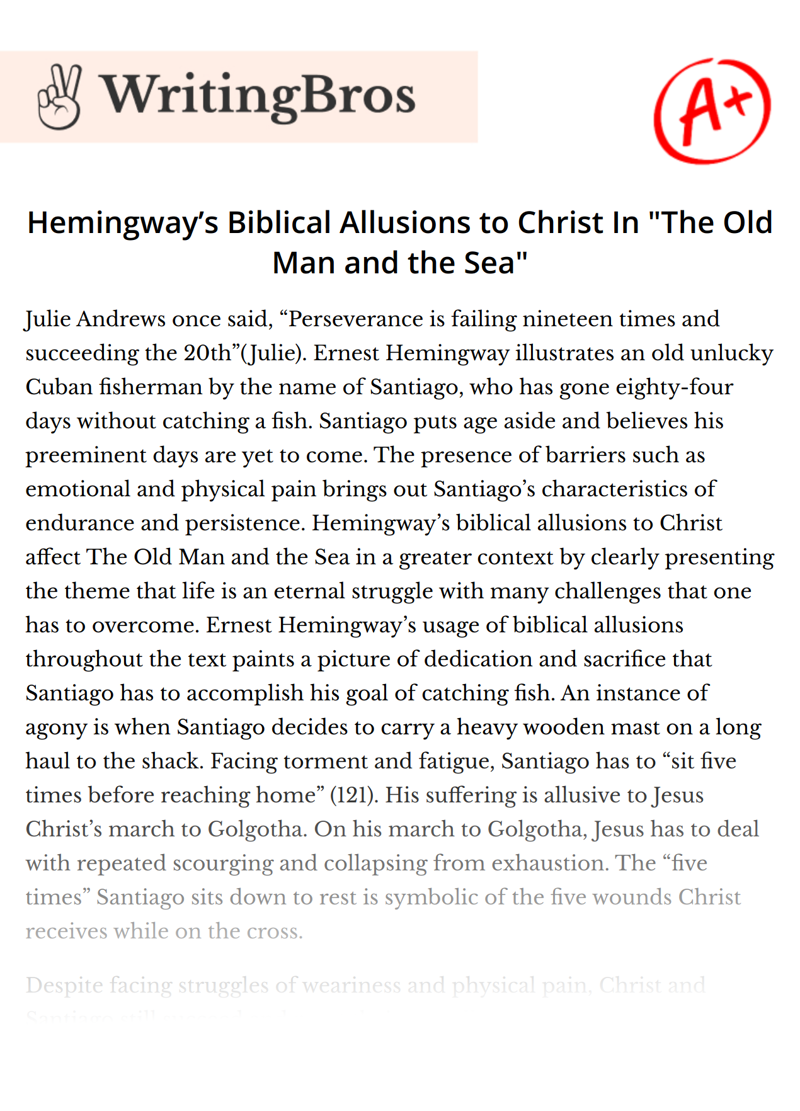Hemingway’s Biblical Allusions to Christ In "The Old Man and the Sea"

Julie Andrews once said, “Perseverance is failing nineteen times and succeeding the 20th”(Julie). Ernest Hemingway illustrates an old unlucky Cuban fisherman by the name of Santiago, who has gone eighty-four days without catching a fish. Santiago puts age aside and believes his preeminent days are yet to come. The presence of barriers such as emotional and physical pain brings out Santiago’s characteristics of endurance and persistence. Hemingway’s biblical allusions to Christ affect The Old Man and the Sea in a greater context by clearly presenting the theme that life is an eternal struggle with many challenges that one has to overcome. Ernest Hemingway’s usage of biblical allusions throughout the text paints a picture of dedication and sacrifice that Santiago has to accomplish his goal of catching fish. An instance of agony is when Santiago decides to carry a heavy wooden mast on a long haul to the shack. Facing torment and fatigue, Santiago has to “sit five times before reaching home” (121). His suffering is allusive to Jesus Christ’s march to Golgotha. On his march to Golgotha, Jesus has to deal with repeated scourging and collapsing from exhaustion. The “five times” Santiago sits down to rest is symbolic of the five wounds Christ receives while on the cross.
Despite facing struggles of weariness and physical pain, Christ and Santiago still succeed and meet their overall goals. The allusion to Christ’s journey to Golgotha and his five wounds while on the cross develop the overall theme that no matter how hard the challenges in life are, one has to persevere in order to reach their desired grail. Ernest Hemingway’s usage of biblical allusions throughout the text paints a picture of dedication and sacrifice that Santiago has to accomplish his goal of catching fish. Breaking his streak, on the eighty-fifth day at noon, Santiago hooks a fish but has strenuous time hauling it out the water. Wrestling with the Marlin, Santiago faces severe injuries. While holding on firmly to the skinny fishing cable, Santiago acquires deep cuts in his wrinkly palms and slashes in his back. The acute cuts in Santiago’s palm are reminiscent of Christ’s bloody palms as he is being pierced to the cross.
While the immense slashes in Santiago’s back symbolizes the scourging Jesus Christ took from the Roman Soldiers. The physical harm that Santiago and Christ face shows how two characters are disposed to sacrificing themselves for a greater cause. Santiago sacrifices himself to make the biggest catch of his life while Jesus sacrifices himself to forgive others of their sins. The cuts on Santiago’s and Christ’s body are a good resemblance of how “ a man can be destroyed but not defeated” (103). Santiago and Jesus may have been bestowed with high hurdles that were damaging but they were still able to jump over them and persist. Hemingway’s utilization of allusions to Christ plays a crucial role in developing the theme that life will hit you with many punches, but to reach one’s goal, one has to be diligent. Santiago’s rigorous journey with the mast being reminiscent of Christ’s journey to Golgotha shows that perseverance is key to success. Another instance of tenacity is when Santiago endures through cuts as Jesus endured through nailing and whipping. As Margaret Thatcher said, “ [One] may have to fight a battle more than once to win it.”
Cite this Essay
To export a reference to this article please select a referencing style below

